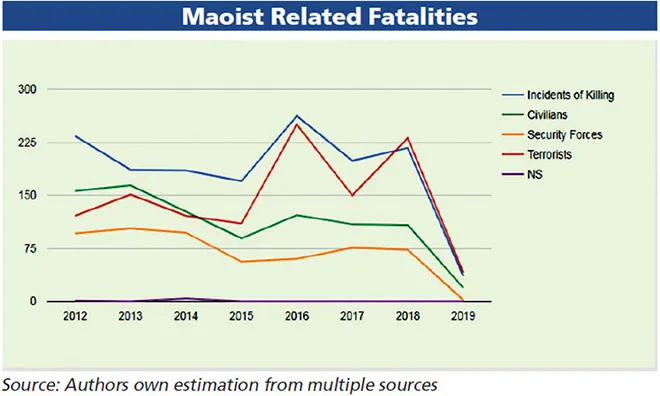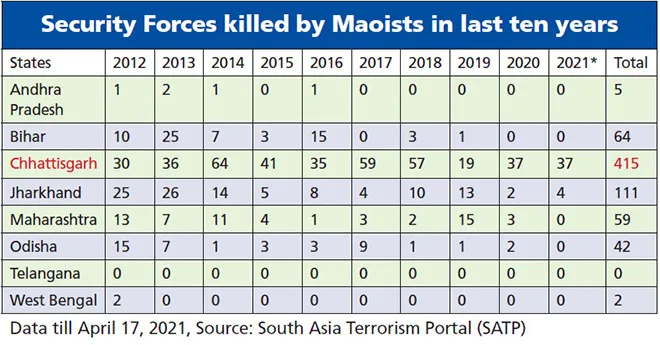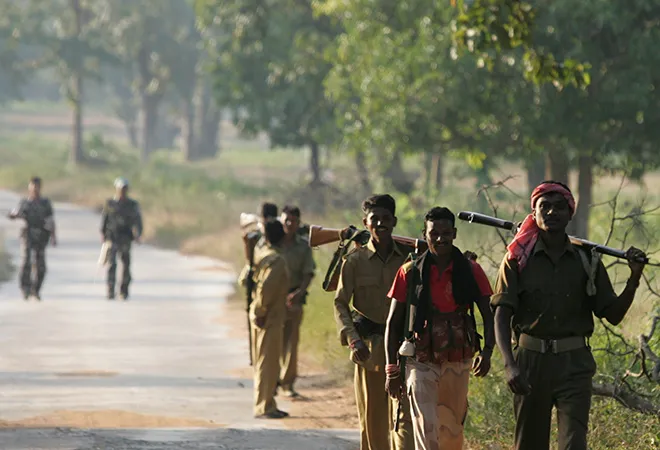In a serious setback to ongoing anti-Maoist operations, 22 security personnel were killed and 31 sustained serious injuries in encounter with the dreaded Maoists along Sukma-Bijapur border in Chhattisgarh. Given the large number of casualties involved including the elite CoBRA commandos of Central Reserve Police Force (CRPF), questions about intelligence failures, security forces committing tactical mistakes and not following up standard operating procedures have been raised by security experts and analysts.
Moreover, this was not a surprise ambush by the Maoists on security forces. Reportedly, this was a major combing operation jointly conducted by CoBRA unit of CRPF, Special Task Force, District Reserve Guard (DRG) and District Force of Chhattisgarh Police to capture the most wanted Maoist No.1 area commander Madvi Hidma. Even before the security team issued any clarification, the chief minister of Chhattisgarh Bhupesh Baghel was quick to reject any chances of intelligence failure which would have been the major factor leading to the loss of lives of security personnel. This is the last thing one expects in a combat situation in any major counterinsurgency (COIN).
The irony is that an attack of this scale and intensity could take place at a time when the Indian state and its security forces are seen to have acquired better combat skills and experience and are believed to be in dominant position compared to the insurgent organisation. Fact of the matter is that the year 2019 (see below graph) saw one of lowest ever casualties among armed forces in the decades. A coordinated and well-calibrated counterinsurgency operation from the federal government and the Naxal-affected states yielded in bringing down Maoist-led violence to an all-time low.
Practically, the ultras real presence has been reduced to few tri-junction districts in Chhattisgarh, Jharkhand and Odisha. No wonder, India’s ministry of home affairs (MHA) removed 44 districts from Naxal affected list, while the ‘worst-affected category’ was brought down to 30 in 2019. As per well-known ACLED data, the spread of Covid-19 pandemic brought down Maoist related incidents in 2020 even further than 2019 (30 per cent less). The country-wide lockdown proved a massive blow for the insurgent organisations as it disrupted their critical supplies and movements.
For all practical purposes, the Maoist organisation’s presence is now confined to Chhattisgarh’s Bastar region having an area of 40,000 square kilometre. This is a stupendous achievement for security forces considering a decade back the Indian state was staring at an insurgency that was spreading like rapid fire and had presence over one-third of territories. Thus, it is imperative to go to the board room and seriously assess what went wrong with the combing operations in Bijapur.

No Lessons Learned
As said earlier, such daring attack by the Maoist organisation at a time when the extremist organisation is at its weakest raises hard questions over the strategy, tactical and intelligence elements involved in existing counterinsurgency operations (COIN). Considering the identical pattern in which the security forces have been trapped and killed by the Maoists, be it in the case of Gadchiroli in Maharashtra in 2019, incidents in the Bijapur-Sukma region in Chhattisgarh in 2019-20, or 2017 Sukma killings of 25 CRPF
jawans, there are serious questions over the preparedness, tactical capabilities, and intelligence-gathering aspects involved in COIN.
A close glance at operational aspects of COIN makes it amply clear that the key reason behind high casualties among security forces is due to flagrant violation of standard operating procedure (SOP). In a combat situation involving a dreaded insurgent group, SOP is what minimises errors and casualties. In COIN, high casualty can considerably demoralise the forces.
Two factors that are responsible for most frequent violation of SOP are over-confidence and complacency. The over-confidence of the security forces against the Maoists mostly stems from the drastic reduction of the Maoist-related violent incidents. While the security forces deserve credit in bringing down the violence, often taking the Maoists for granted have proved too costly for them. Moreover, one can also observe the complacent attitude of the security forces against the Maoists.
In fighting a protracted battle against the ultras for more than one and half decades with huge success the security forces are seen to have brought fatigue and complacency. While the security forces are engaged in mounting operations against the Maoists, the latter is waiting for that moment of lapse or complacency of the forces. The Maoist, notwithstanding, their weakening strength continue to maintain a tactical edge over the security forces and launch time to time surprise attacks in their zones, while the forces seem to repeat the same mistake at every interval.
Issues with Central Paramilitary
A major challenge that the CAPF deployed in the Maoist affected areas faces is weak or ineffective coordination with the state police. The crux of the lack of coordination lies with the fact that while the state police forces are legally empowered to maintain the law-and-order issues, the CAPF carries the burden of containing the Maoists. It is important to mention that the dominant narrative understands the Maoist violence as a law-and-order issue.
Paradoxically, the roles of the state police forces and that of the CAPF have been asymmetric. Over the years the security forces belonging to the CAPF, especially in Chhattisgarh, have lost more lives compared to the state police force (See Table). The lack of coordination among these forces reflects badly on the critical issues of sharing information about the Maoists, joint operations, and helping the CAPF getting used to the local language and other details.
However, this critical issue of lack of coordination between the CAPF and the state police is hardly highlighted or discussed in the open forum or any task force that has been constituted to examine and revisit the ongoing security operations against Maoists.

Some of the important problems at the organisational and structural levels of respective CAPF are also no less responsible for the major casualties suffered by them in encounter with the Maoists from time to time. Particularly the CRPF, which is heavily deployed to fight the Maoists has been a victim of several issues relating to recruitment, promotion, and leadership. Most of the personnel in the CRPF recruited as constables take years to be promoted. It is a reality that most of them retire at a low rank.
Moreover, the leadership of the force has always been an officer drawn from the Indian Police Service (IPS) and whose tenure as the head of the force is for a limited period. It is safe to mention that such a practice has led to a huge gap between the leadership and the personnel in the CRPF. Deprived of the privileges of promotion and recognition to their services, the CRPF personnel have raised these issues with successive governments only to get lip service of assurance of reformation.
This is an important factor contributing to the low morale of the CRPF personnel fighting the Maoist ultras. Adding to the existing difficulties, the CRPF always needs to take the local Superintendent of Police (SP) for any operation against the Maoists. Such legalities dilute the independence of a professional force like CRPF. In addition to this, the IPS leadership of the CRPF is hardly held accountable for the loss of lives that the latter suffers from. These organisational and structural complications in CRPF are vital factors that have direct implications on the low morale of the security forces in the combat zones.
Another less debated issue with regard to COIN is poor intelligence gathering and sharing often leading to the tactical failures during combing operations against the Maoists. This has been the trend in the last 10 years or so. Not well-versed with the local language and traditions the CAPF deployed in the Maoists-affected areas often find it difficult to establish effective communication with the local people.
Moreover, the presence of the CAPF personnel in the Maoist affected areas which are mostly inhabited by the tribal and other marginalised communities is seen with suspicion and fear. In this process, they have not been able to penetrate the Maoist ranks and files for credible and actionable intelligence. The surrendered Maoists are often seen to be close to the state police rather than the CAPFs. The lack of credible or complete information on the movement and planning of the Maoists has also contributed to the loss of lives among the security forces.
Culture of Accountability
To conclude, even after more than a decade of hard combat against the dreaded Maoist organisation, both state and central security forces particularly in Chhattisgarh, the key theatre of current anti-Maoist operations continue to suffer the same fate. When Maoist did a major ambush in Dantewada killing as many as 76 CRPF soldiers in 2010 and the MHA constituted a taskforce headed by E.N. Ramamohan, a decorated former chief of the Border Security Force to investigate the reasons for such high casualties among security forces, many believed that this would be the last major incident.
However, the country, especially Chhattisgarh, has been experiencing several incidents of major Maoist attacks involving high casualties among security forces. The answers for such tragic episodes are not difficult to find. As demonstrated earlier, neither there is any systemic learning evident in frequent breaches in SOP, nor any institutional accountability fixed for such major incidents.
Other than 2010 Dantewada incident, at no other time has the head of CRPF or other security organisations including state police have faced probe or accountability questions. No politician (read minister) has ever paid a price for serious state failures in combating the ultras. In short, to win the Maoists, India urgently needs a culture of accountability, be it police, intelligence, security bureaucracy and the politician.
This commentary originally appeared in Force India.
The views expressed above belong to the author(s). ORF research and analyses now available on Telegram! Click here to access our curated content — blogs, longforms and interviews.





 Some of the important problems at the organisational and structural levels of respective CAPF are also no less responsible for the major casualties suffered by them in encounter with the Maoists from time to time. Particularly the CRPF, which is heavily deployed to fight the Maoists has been a victim of several issues relating to recruitment, promotion, and leadership. Most of the personnel in the CRPF recruited as constables take years to be promoted. It is a reality that most of them retire at a low rank.
Moreover, the leadership of the force has always been an officer drawn from the Indian Police Service (IPS) and whose tenure as the head of the force is for a limited period. It is safe to mention that such a practice has led to a huge gap between the leadership and the personnel in the CRPF. Deprived of the privileges of promotion and recognition to their services, the CRPF personnel have raised these issues with successive governments only to get lip service of assurance of reformation.
This is an important factor contributing to the low morale of the CRPF personnel fighting the Maoist ultras. Adding to the existing difficulties, the CRPF always needs to take the local Superintendent of Police (SP) for any operation against the Maoists. Such legalities dilute the independence of a professional force like CRPF. In addition to this, the IPS leadership of the CRPF is hardly held accountable for the loss of lives that the latter suffers from. These organisational and structural complications in CRPF are vital factors that have direct implications on the low morale of the security forces in the combat zones.
Another less debated issue with regard to COIN is poor intelligence gathering and sharing often leading to the tactical failures during combing operations against the Maoists. This has been the trend in the last 10 years or so. Not well-versed with the local language and traditions the CAPF deployed in the Maoists-affected areas often find it difficult to establish effective communication with the local people.
Moreover, the presence of the CAPF personnel in the Maoist affected areas which are mostly inhabited by the tribal and other marginalised communities is seen with suspicion and fear. In this process, they have not been able to penetrate the Maoist ranks and files for credible and actionable intelligence. The surrendered Maoists are often seen to be close to the state police rather than the CAPFs. The lack of credible or complete information on the movement and planning of the Maoists has also contributed to the loss of lives among the security forces.
Some of the important problems at the organisational and structural levels of respective CAPF are also no less responsible for the major casualties suffered by them in encounter with the Maoists from time to time. Particularly the CRPF, which is heavily deployed to fight the Maoists has been a victim of several issues relating to recruitment, promotion, and leadership. Most of the personnel in the CRPF recruited as constables take years to be promoted. It is a reality that most of them retire at a low rank.
Moreover, the leadership of the force has always been an officer drawn from the Indian Police Service (IPS) and whose tenure as the head of the force is for a limited period. It is safe to mention that such a practice has led to a huge gap between the leadership and the personnel in the CRPF. Deprived of the privileges of promotion and recognition to their services, the CRPF personnel have raised these issues with successive governments only to get lip service of assurance of reformation.
This is an important factor contributing to the low morale of the CRPF personnel fighting the Maoist ultras. Adding to the existing difficulties, the CRPF always needs to take the local Superintendent of Police (SP) for any operation against the Maoists. Such legalities dilute the independence of a professional force like CRPF. In addition to this, the IPS leadership of the CRPF is hardly held accountable for the loss of lives that the latter suffers from. These organisational and structural complications in CRPF are vital factors that have direct implications on the low morale of the security forces in the combat zones.
Another less debated issue with regard to COIN is poor intelligence gathering and sharing often leading to the tactical failures during combing operations against the Maoists. This has been the trend in the last 10 years or so. Not well-versed with the local language and traditions the CAPF deployed in the Maoists-affected areas often find it difficult to establish effective communication with the local people.
Moreover, the presence of the CAPF personnel in the Maoist affected areas which are mostly inhabited by the tribal and other marginalised communities is seen with suspicion and fear. In this process, they have not been able to penetrate the Maoist ranks and files for credible and actionable intelligence. The surrendered Maoists are often seen to be close to the state police rather than the CAPFs. The lack of credible or complete information on the movement and planning of the Maoists has also contributed to the loss of lives among the security forces.
 PREV
PREV


